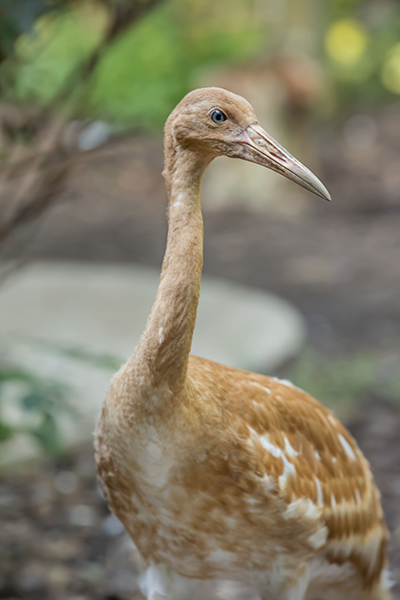
Media contact: Pamela Seelman, Marketing Director, International Crane Foundation, 608-320-0685.
We are excited to cross-post this story from our colleagues at the Milwaukee County Zoo in Wisconsin. The zoo’s Whooping Crane pair – Tiki and Torch – became proud foster parents this spring after receiving an egg from our headquarters. The chick’s genetics are important for the captive Whooping Crane population, and as a result, the young crane will remain in captivity to help with the species’ recovery.
The Milwaukee County Zoo is excited to announce the arrival and hatching of a Whooping Crane foster egg! The Zoo received the egg from the International Crane Foundation on May 29 with the hope that resident Whooping Crane pair, Torch and Tiki, would incubate the egg. They did, and a healthy female chick hatched June 1. Torch and Tiki are doing an excellent job as “foster parents,” and are teaching the chick important life skills, such as how to forage and obtain food. The privacy fencing around their habitat near the Herb and Nada Mahler Family Aviary will remain in place until the parents become less protective of the chick. But because she has grown considerably, she’s currently visible from the edge of the public pathway.
Zookeepers and vets closely monitored the chick’s weight and health for the first few days. After seeing the chick was healthy and gaining weight, staff only handled her one more time, for her 30-day vaccinations.

Early in 2021, the International Crane Foundation decided it wouldn’t costume-rear chicks due to COVID restrictions and the uncertainty of when vaccines would be available. The Association of Zoos and Aquariums (AZA) Whooping Crane Species Survival Plan (SSP) and the U.S. Fish and Wildlife Service jointly agreed to place genetically valuable eggs with pairs at non-breeding facilities that were deemed suitable. These “genetic holdback” eggs have genetics that are under-represented in zoos and valuable for future captive breeding. The Milwaukee County Zoo was chosen to receive an egg based on its crane husbandry experience, continued support of the Whooping Crane Reintroduction Project, and having a suitable pair timed to accept an egg.
At the time the International Crane Foundation was looking to transfer an egg, Torch and Tiki were incubating an infertile egg, which, had it been fertile, would have had a hatch date very close to the hatch date of the egg received from the International Crane Foundation. Because of this, and the fact that Torch and Tiki displayed strong incubation behaviors in the past, it was likely the pair would accept and care for the International Crane Foundation egg.
Torch arrived at the International Crane Foundation as an egg from the Calgary Zoo in June 2006 and came to the Zoo in October 2006. He originally was reared for release in the fall in Wisconsin but was removed from the program when he was found with a wing injury of unknown origin. Because of this injury, he could not be re-released into the wild. Tiki hatched from an egg produced in the wild by a pair at the Necedah National Wildlife Refuge.
The egg was transferred to the USGS Patuxent Wildlife Research Center in Maryland where Tiki also was reared for release. Due to health concerns, she was removed from the project as a release candidate and was transferred to the Zoo as a companion for Torch.
Whooping Cranes can be extremely aggressive and protective when nesting and caring for their chicks. As soon as an egg is laid in a habitat, the pair will no longer allow zookeepers to enter the area for more than a few minutes, and only basic tasks, such as setting out food and water, can be accomplished. The zookeeper doing these tasks must be accompanied by another keeper who acts as a protector. When the chick hatches, at least four keepers are required to service the habitat; three act as protectors for the fourth who is replacing food and water, and tidying the area. Torch and Tiki exhibiting this behavior is a good sign, as it indicates that they are caring for the chick as if it was their own.
Most likely, the chick will remain at the Zoo with Torch and Tiki until late fall of 2021. In the meantime, the Whooping Crane SSP will determine the best placement for the chick by evaluating the transfer recommendations.
The Zoo will update visitors as to when they’ll be able to see the chick in the Whooping Crane habitat, which is located near the exit of the Herb and Nada Mahler Family Aviary.
